
The common buzzard is a medium-to-large bird of prey which has a large range. A member of the genus Buteo, it is a member of the family Accipitridae. The species lives in most of Europe and extends its breeding range across much of the Palearctic as far as the northwestern China, far western Siberia and northwestern Mongolia. Over much of its range, it is a year-round resident. However, buzzards from the colder parts of the Northern Hemisphere as well as those that breed in the eastern part of their range typically migrate south for the northern winter, many culminating their journey as far as South Africa. The common buzzard is an opportunistic predator that can take a wide variety of prey, but it feeds mostly on small mammals, especially rodents such as voles. It typically hunts from a perch. Like most accipitrid birds of prey, it builds a nest, typically in trees in this species, and is a devoted parent to a relatively small brood of young. The common buzzard appears to be the most common diurnal raptor in Europe, as estimates of its total global population run well into the millions.

The common crane, also known as the Eurasian crane, is a bird of the family Gruidae, the cranes. A medium-sized species, it is the only crane commonly found in Europe besides the demoiselle crane. Along with the sandhill and demoiselle cranes and the brolga, it is one of only four crane species not currently classified as threatened with extinction or conservation dependent on the species level. Despite the species' large numbers, local extinctions and extirpations have taken place in part of its range, and an ongoing reintroduction project is underway in the United Kingdom.

The killdeer is a large plover found in the Americas. It was described and given its current scientific name in 1758 by Carl Linnaeus in the 10th edition of his Systema Naturae. There are three subspecies. The killdeer's common name comes from its often-heard call. Its upperparts are mostly brown with rufous fringes, the head has patches of white and black, and there are two black breast bands. The belly and the rest of the breast are white. The nominate subspecies breeds from southeastern Alaska and southern Canada to Mexico. It is seen year-round in the southern half of its breeding range; the subspecies C. v. ternominatus is probably resident in the West Indies and C. v. peruvianus inhabits Peru and areas of the surrounding countries throughout the year. North American breeders winter from their resident range south to Central America, the West Indies, and the northernmost portions of South America.

The piping plover is a small sand-colored, sparrow-sized shorebird that nests and feeds along coastal sand and gravel beaches in North America. The adult has yellow-orange-red legs, a black band across the forehead from eye to eye, and a black stripe running along the breast line. This chest band is usually thicker in males during the breeding season, and it is the only reliable way to tell the sexes apart. The bird is difficult to see when it is standing still, as it blends well with open, sandy beach habitats. It typically runs in short spurts and stops.

The red-footed falcon, formerly the western red-footed falcon, is a bird of prey. It belongs to the family Falconidae, the falcons. This bird is found in eastern Europe and Asia although its numbers are dwindling rapidly due to habitat loss and hunting. It is migratory, wintering in Africa. It is a regular wanderer to western Europe, and in August 2004 a red-footed falcon was found in North America for the first time on the island of Martha's Vineyard, Massachusetts.

Cooper's hawk is a medium-sized hawk native to the North American continent and found from southern Canada to Mexico. This species is a member of the genus Accipiter, sometimes referred to as true hawks, which are famously agile, relatively small hawks common to wooded habitats around the world and also the most diverse of all diurnal raptor genera. As in many birds of prey, the male is smaller than the female. The birds found east of the Mississippi River tend to be larger on average than the birds found to the west. It is easily confused with the smaller but similar Sharp-shinned hawk.

The red-tailed hawk is a bird of prey that breeds throughout most of North America, from the interior of Alaska and northern Canada to as far south as Panama and the West Indies. It is one of the most common members within the genus of Buteo in North America or worldwide. The red-tailed hawk is one of three species colloquially known in the United States as the "chickenhawk", though it rarely preys on standard-sized chickens. The bird is sometimes also referred to as the red-tail for short, when the meaning is clear in context. Red-tailed hawks can acclimate to all the biomes within their range, occurring on the edges of non-ideal habitats such as dense forests and sandy deserts. The red-tailed hawk occupies a wide range of habitats and altitudes including deserts, grasslands, coniferous and deciduous forests, agricultural fields and urban areas. Its latitudinal limits fall around the tree line in the Arctic and the species is absent from the high Arctic. It is legally protected in Canada, Mexico, and the United States by the Migratory Bird Treaty Act.

The cliff swallow or American cliff swallow is a member of the passerine bird family Hirundinidae, the swallows and martins. The scientific name is derived from Ancient Greek; Petrochelidon originates from the petros meaning "rock" and khelidon "swallow", pyrrhonota comes from purrhos meaning "flame-coloured" and -notos "-backed".

The Blackburnian warbler is a small New World warbler. They breed in eastern North America, from southern Canada, westwards to the southern Canadian Prairies, the Great Lakes region and New England, to North Carolina.

The steppe eagle is a large bird of prey. Like all eagles, it belongs to the family Accipitridae. The steppe eagle's well-feathered legs illustrate it to be a member of the subfamily Aquilinae, also known as the "booted eagles". This species was once considered to be closely related to the non-migratory tawny eagle and the two forms have previously been treated as conspecific. They were split based on pronounced differences in morphology and anatomy; two molecular studies, each based on a very small number of genes, indicate that the species are distinct but disagree over how closely related they are.

The cave swallow is a medium-sized, squarish tailed swallow belonging to the same genus as the more familiar and widespread cliff swallow of North America. The cave swallow, also native to the Americas, nests and roosts primarily in caves and sinkholes.

Kīlauea Point National Wildlife Refuge is a National Wildlife Refuge on the northwest coast of the island of Kauaʻi in Hawaiʻi.
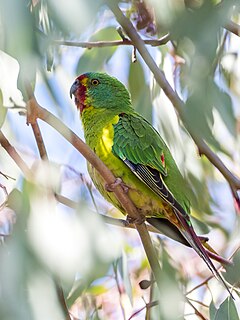
The swift parrot, is a species of broad-tailed parrot, only found in southeastern Australia. The species breeds in Tasmania during the summer and migrates north to south eastern mainland Australia from Griffith-Warialda in New South Wales and west to Adelaide in the winter. It is a nomadic migrant, and it settles in an area only when there is food available. The species is critically endangered and the severe predation of sugar gliders on breeding females and nests. Sugar glider predation is worst where logging is severe, so these threats interact in Tasmania. Genetic evidence for the effective population size suggests that the minimum potential population size is now fewer than 300 individual swift parrots. The genetic evidence supports the results of earlier studies that use demographic information about swift parrots to show the species could be extinct by 2031.
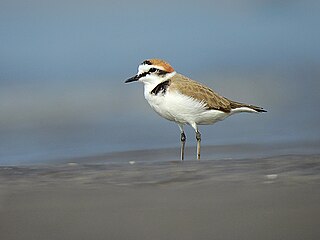
The Kentish plover is a small cosmopolitan shorebird of the family Charadriidae that breeds on the shores of saline lakes, lagoons, and coasts, populating sand dunes, marshes, semi-arid desert, and tundra. Both male and female birds have pale plumages with a white underside, grey/brown back, dark legs and a dark bill, however additionally the male birds also exhibit very dark incomplete breast bands, and dark markings either side of their head, therefore the Kentish plover is regarded as sexually dimorphic
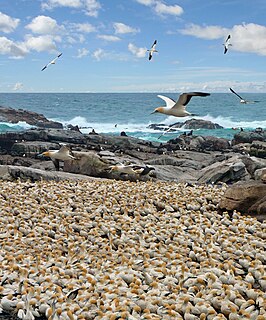
A bird colony is a large congregation of individuals of one or more species of bird that nest or roost in proximity at a particular location. Many kinds of birds are known to congregate in groups of varying size; a congregation of nesting birds is called a breeding colony. Colonial nesting birds include seabirds such as auks and albatrosses; wetland species such as herons; and a few passerines such as weaverbirds, certain blackbirds, and some swallows. A group of birds congregating for rest is called a communal roost. Evidence of colonial nesting has been found in non-neornithine birds (Enantiornithes), in sediments from the Late Cretaceous (Maastrichtian) of Romania.
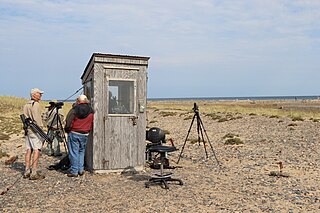
The Whitefish Point Bird Observatory (WPBO) is located in Chippewa County, Michigan, USA, adjacent to the Whitefish Point Unit of the Seney National Wildlife Refuge. It operates as a non-profit, affiliate education and research facility of the Michigan Audubon Society. The Society and the WPBO together have recorded over 300 species of birds at Whitefish Point. As one of a network of bird observatories in the Canadian Migration Monitoring Network, the WPBO documents the bird population of the Great Lakes region through bird banding, data collection, and research studies.
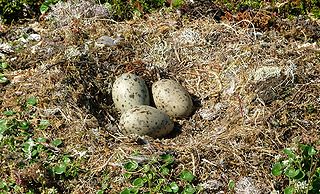
Clutch size refers to the number of eggs laid in a single brood by a nesting pair of birds. The numbers laid by a particular species in a given location are usually well defined by evolutionary trade-offs with many factors involved, including resource availability and energetic constraints. Several patterns of variation have been noted and the relationship between latitude and clutch size has been a topic of interest in avian reproduction and evolution. David Lack and R.E. Moreau were among the first to investigate the effect of latitude on the number of eggs per nest. Since Lack's first paper in the mid-1940s there has been extensive research on the pattern of increasing clutch size with increasing latitude. The proximate and ultimate causes for this pattern have been a subject of intense debate involving the development of ideas on group, individual, and gene-centric views of selection.

Migrating birds face many perils as they travel between breeding and wintering grounds each year.

The red-shouldered hawk is a medium-sized hawk. Its breeding range spans eastern North America and along the coast of California and northern to northeastern-central Mexico. It is a permanent resident throughout most of its range, though northern birds do migrate, mostly to central Mexico. The main conservation threat to the widespread species is deforestation.

Altitudinal migration is a short-distance animal migration from lower altitudes to higher altitudes and back. It is commonly thought to happen in response to climate and food availability changes as well as increasingly due to anthropogenic influence. These migrations can occur both during reproductive and non-reproductive seasons. Altitudinal avian migration is common, and can also be found in other vertebrates, and can be seen in some invertebrates.



















